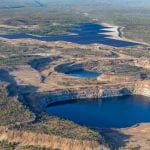Feed aggregator
Budget cuts to climate funding mean NZ may now struggle to meet its international obligations
EU scientific advisors tell newly-elected Parliament to stay the course on climate
NZ warned it risks repeating past mistakes on ETS settings, consultation
Japanese energy giant gets FIRB tick for Genex bid, lays out plans for big wind project
The post Japanese energy giant gets FIRB tick for Genex bid, lays out plans for big wind project appeared first on RenewEconomy.
Nature-based climate solutions gain traction in Global South cities, but challenges remain -report
Marine CO₂ removal technologies could depend on the appetite of the ocean’s tiniest animals
The Guardian view on the climate crisis and heatwaves: a killer we need to combat | Editorial
Britain may be chilly, but from Greece to India, people are dying due to record temperatures. The death toll will grow without urgent action
While Britons don jumpers and complain about the unseasonable cold, much of the world has been reeling due to excessive temperatures. India has been in the grip of its longest heatwave in recorded history, with thermometers hitting 50C in some places. Greece closed the Acropolis in the afternoon last week as temperatures hit 43C; never has it seen a heatwave so early in the year. Soaring temperatures in the Sahel and western Africa saw mortuaries in Mali reportedly running short of space this spring, while swathes of Asia suffered in May.
Mexico and the south-west of the US have also endured blistering conditions; it was particularly shocking to hear Donald Trump pledge again to “drill, baby, drill” at a rally that saw supporters taken to hospital with heat exhaustion. These bouts of extreme weather are increasing as the climate crisis worsens. Although the El Niño weather pattern contributed to heatwaves over the last 12 months, they are becoming more frequent, extreme and prolonged thanks to global heating. By 2040, almost half the world’s inhabitants are likely to experience major heatwaves, 12 times more than the historic average.
Continue reading...We should embrace our inner goddess – but let’s not create another test for women to fail | Jackie Bailey
You don’t have to wear a floral wreath or take milk baths to adhere to a modern goddess philosophy
- Making sense of it is a column about spirituality and how it can be used to navigate everyday life
When I am on deadline, nothing yet defrosted for dinner, and the washing is hanging on the clothesline in the rain, I find it hard to connect to my inner goddess. If I turn to the internet for advice, I’m presented with yet another to-do list.
To embrace my goddess self, I must love myself, eat healthy, exercise, take a milk bath, wear flattering-yet-practical clothes, adorn my hair with floral wreathes and fix its frizziness with an avocado. I must use “natural looking” makeup, maintain a healthy skincare regimen, always be kind yet assertive, lead by inspiring …
Sign up for a weekly email featuring our best reads
Continue reading...US braces for ‘dangerous’ conditions as heatwave to hit midwest and north-east
Meteorologists warn that heat will spread east through the week, with ‘heat dome’ expected to trap high temperatures
Millions of Americans are facing “dangerously hot conditions”, the National Weather Service said, with a heatwave set to hit the midwest and north-east US from Monday.
Michigan, Ohio and western Pennsylvania were all under heat warnings starting Monday, with alerts in place until Friday evening. Meteorologists warned that the heat will spread east through the week, with a “heat dome” expected to trap high temperatures across New York, Washington DC and Boston.
Continue reading...Ecuador’s president won’t give up on oil drilling in the Amazon. We plan to stop him – again | Nemonte Nenquimo
This forest is our home, our existence and our children’s future. Politicians who can’t resist selling it for oil cash will feel the strength of the Waorani people
In 2019 I helped lead a movement that defeated the Ecuadorian government’s plans to auction half a million acres of Waorani territory in the Amazon to oil companies. We showed in court that the government had violated its legal obligation to obtain free, prior and informed consent from Indigenous communities. We won a moral and legal victory on behalf of our ancestral home in that moment – or so we thought. Now, however, Ecuador’s president plans to plough through that legal judgment and recommence oil drilling on nearby Indigenous lands. He obviously hasn’t reckoned with the strength and tenacity of the Waorani people.
In winning that landmark legal case, we protected pristine rainforest lands, Indigenous autonomy and our planet’s climate from further deforestation. We protected our homes, our children’s future and the forests where I grew up playing with my siblings and pet monkeys, learning to garden and make fresh chicha, and where my people still live today. No more destroying our lives, homes and forests to pump the blood of our ancestors from beneath the soil.
Do you have an opinion on the issues raised in this article? If you would like to submit a response of up to 300 words by email to be considered for publication in our letters section, please click here.
Continue reading...Beagling, golf and jolly hockey sticks: outdoor life at England’s largest private schools
Guardian investigation reveals vast gap in outdoor space and lists the top 10 schools with the most of all
- Revealed: private schools have 10 times more green space than state schools
- Analysis: Green space better for young brains than we realised
- How England’s top private schools came to own 38,000 acres of land
A handful of schools, the Guardian’s analysis has found, have campuses that stretch over hundreds of acres. So what, exactly, do the 10 largest schools (by area) offer their lucky students?, and how do they go about sharing their grounds with other children?
Continue reading...Revealed: private schools have 10 times more green space than state schools
Guardian investigation finds pupils at England’s wealthiest schools have much greater access to land, with implications for mental health
- Analysis: Green space better for young brains than we realised
- How England’s top private schools came to own 38,000 acres of land
- Beagling, golf and jolly hockey sticks: outdoor life at England’s largest private schools
Children at the top 250 English private schools have more than 10 times as much outdoor space as those who go to state schools, an exclusive Guardian analysis can reveal.
A schoolboy at fee-charging Eton has access to 140 times more green space than the average English state school pupil, the analysis found. Experts condemned the “staggering” and “gross” inequalities.
The average student at one of England’s top private schools has access to approximately 322 sq metres of green space, whereas the average state school student has access to about 32 sq metres of green space: a ratio of 10:1.
Eton students enjoy the largest area of land of all the schools in the country, with its schoolboys having access to 4,445 sq metres per pupil an area, 140 times larger than that available to the average state school student. Some of that land is also accessible to the public.
The private school campuses include tennis courts, golf courses, rowing lakes, swimming pools, equestrian centres, wilderness areas, and remote camping lodges.
In contrast, some state schools have little or no green space at all for their students.
Continue reading...Bagging a Munro gets easier as volunteers fund repairs to mountain paths
Scottish Highlands campaign has raised two-thirds of £300,000 target for footpaths on An Teallach. But more is needed to protect people and environment
One of Scotland’s most impressive and recognisable mountains will have its walking paths restored after hillwalkers and charities clubbed together to raise hundreds of thousands of pounds.
Mountaineering Scotland and the Outdoor Access Trust for Scotland (Oats) launched a campaign last May to raise £300,000 for essential path repairs on An Teallach in Wester Ross, in the north-west Highlands, asking walkers and climbers to “give the hill a few quid”. The It’s Up to Us campaign has announced that £218,000 has already been donated.
Continue reading...Approval fast tracked for first of huge solar and wind projects to power giant iron ore mines
The post Approval fast tracked for first of huge solar and wind projects to power giant iron ore mines appeared first on RenewEconomy.
Australia’s biggest solar farm has a highly profitable first quarter after construction delays
 Australia's biggest solar farm enjoyed a highly profitable first quarter of the year.
Australia's biggest solar farm enjoyed a highly profitable first quarter of the year.
The post Australia’s biggest solar farm has a highly profitable first quarter after construction delays appeared first on RenewEconomy.
Clean air zones: What is the money raised spent on?
Are animals conscious? How new research is changing minds
Disastrous, dark shadow, destroys our economy: five climate elders on Peter Dutton’s emissions stance
From Peter Garrett to Prof Lesley Hughes there is frustration, despair and ‘a towering sense of anger’ over the opposition leader’s shift on the 2030 target
Any sense of a ceasefire in Australia’s fractious climate wars was blown away this week after the Coalition said it would not back the country’s 2030 emissions reduction target at the next election.
Peter Dutton’s declaration would mean that, if elected, a Coalition government will seek to breach a central tenet of the global Paris climate accord that countries should not “backslide” on their climate ambition.
Continue reading...Voluntary carbon project developer shuts down, lays off remaining staff -media
Outdoor clothing brands still using ‘forever chemicals’ despite health risk
Campaigners find PFAS, which can contaminate the soil and water supply, in more than 80% of 27 companies’ products
Hikers may be inadvertently damaging the environment and risking their own health by wearing clothes made waterproof with “forever chemicals”, according to research by Ethical Consumer.
The campaigning magazine examined 27 companies that make outdoor clothing such as fleeces, waterproof jackets, walking boots and rucksacks, and found 82% were still using per- and polyfluoroalkyl substances, or PFAS.
Continue reading...




